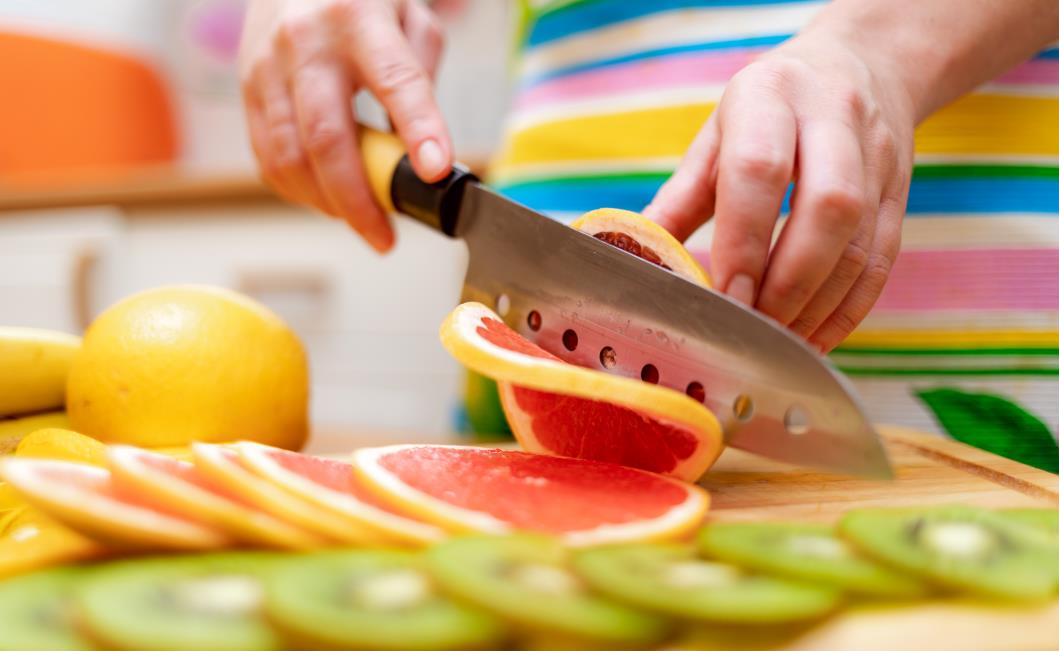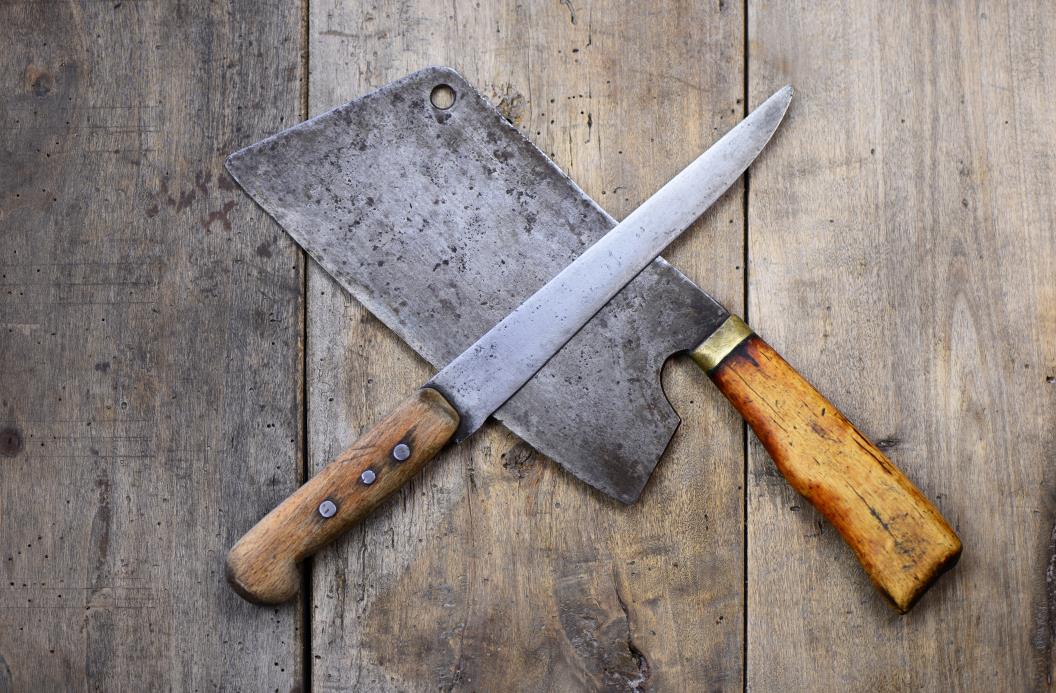If you are considering upgrading your kitchen knife, AUS 8 is a name that will definitely come up during your research. Perhaps you have heard some positive things about this material, or maybe you’ve seen the chemical composition but are uncertain about how these knives perform in practice.
AUS 8 steel is a higher-end steel made in Japan. It is considered stainless because of its high chromium content. AUS 8 steel demonstrates excellent corrosion resistance, as well as a high hardness rating of around 59 HRC. The steel also offers impressive toughness and wear resistance. In short, AUS 8 steel offers similar properties to high-end carbon steel while maintaining the durability of stainless steel.
Looking at the composition of an alloy can be confusing since you have no idea what a combination of elements will create. We will discuss the components of this stainless steel and explain how each affects the metal’s behavior. We will then compare AUS 8 to other types of steel and find out if it is a good knife material.
Table of contents
What is AUS 8 steel?
AUS 8 is Japanese steel that is manufactured by the Aichi metal company. Aichi supplies plates of high-quality metal to other companies that make products like kitchen knives. AUS 8 is just one grade in the AUS steel series, on par with AUS 1, AUS 4, AUS 6, and AUS 10. The higher the number goes, the higher the carbon content.
You can see the full composition of AUS 8 below, but the main difference between these grades is that higher numbers have an increasing carbon component.
What about AUS 8a steel?
You may have heard about AUS 8a steel and are perhaps interested in how it differs from regular AUS 8 steel. While they are the same alloy, 8a steel has simply undergone some form of heat treatment to improve its hardness or edge retention.
The composition of AUS 8 steel
- Carbon (C): 0.7-0.8%
- Chromium (Cr): 13-14.5%
- Silicon (Si): ≤ 0.8%
- Manganese (Mn): ≤ 0.5%
- Nickel (Ni): ≤ 0.3%
- Molybdenum (Mo): 0.1-0.3%
- Vanadium (V): 0.1-0.25%
- Phosphorus (P): ≤ 0.04%
As with all steels, the primary material component is iron (Fe). The fact that AUS 8 steel contains over 10.5% chromium means that it is a stainless steel alloy. Stainless steel is known both for its shiny appearance and anti-rust properties. The chromium binds with oxygen on the metal surface to prevent the formation of iron oxide.
Carbon is the other key ingredient needed to create steel. If a steel alloy has a carbon weight component of over 0.6%, then it is considered high carbon. This is the case for AUS 8, so it is both a stainless and a high-carbon steel alloy. Carbon is known for increasing the hardness of steel and making it less vulnerable to scratching. On the other hand, high levels of carbon can also make steel brittle.
Nickel and Molybdenum assist the chromium by improving corrosion resistance further. Nickel also provides the AUS 8 alloy with extra toughness to balance any brittleness introduced by carbon.
Manganese increases the steel’s hardenability. In the case of AUS 8a steel, this allows the blade to gain better edge retention and wear resistance through heat treatments. Adding silicon and vanadium to the alloy increases the metal’s tensile strength.
This is quite a complex combination, but each of the elements contributes to improving the metal’s properties.
How does AUS 8 steel behave as a knife material?

Hardness & edge retention
As we mentioned, AUS 8 steel is considered a high carbon steel thanks to the high mass of carbon contained within the alloy. The Rockwell hardness rating of this metal is estimated at 58-59, which is certainly good for a kitchen knife.
The hardness of the steel translates to good edge retention. While AUS 8 steel knives are not as good as premium high-carbon knives at holding an edge, this is still an impressive figure.
So, you can chop on a cutting board for many hours without the edge becoming dull. Compared with other types of stainless steel, the edge of an AUS 8 knife will last for a while, though will still need occasional sharpening.
Toughness
Considering the hardness of AUS 8 steel, you might expect that toughness is sacrificed. This is not true. While AUS 8 is high-carbon steel, it is also stainless. The chromium and nickel protect the alloy against cracking and chipping.
An AUS 8 knife can absorb quite a lot of energy without breaking. This means it is not a bad choice for inexperienced knife users who may accidentally drop it. This toughness is also very useful for hunting and folding knives.
Corrosion resistance
A big advantage of using an AUS 8 knife instead of a standard high-carbon knife is the superior corrosion resistance. The main job of the chromium in this alloy is to prevent rust from developing on the blade surface. Rust will not only make your blade look ugly but could also contaminate your meals.
Because of this, this knife can stay wet for extended periods without any worries of corrosion. This is very beneficial in a humid kitchen where you have to chop many wet ingredients like fish and vegetables. Rust may still appear on stainless steel, but this will take much longer.
Wear resistance
A weakness of standard stainless steel is that it’s quite soft, so its shiny surface can be ruined by scratches. AUS 8 steel has decent wear resistance thanks to the presence of carbon and molybdenum within the alloy. Hence, even when you cut through hard ingredients like crusty bread or nuts, the beautiful shiny blade will stay scratch-free.
Of course, you don’t want to encourage scratches to form. You should avoid putting the knife in a sink or dishwasher where other hard items can harm the blade. Whether it is an outdoor or kitchen knife, it is also vital to store it properly.
Sharpening
An AUS 8 stainless steel knife retains its edge quite well. Luckily, it’s fairly easy to sharpen it once it becomes dull. AUS 8 steel is not extremely hard so sharpening doesn’t require too much effort. Whether you prefer using a whetstone or an electric sharpener, the edge will be sharp in no time.
AUS 8 steel vs other knife steels

AUS 8 vs other stainless steels
The stainless steels most similar to AUS 8 are the 440 series alloys. They all contain 16-18% chromium plus 0.75% molybdenum. This suggests that a 440 steel knife is less vulnerable to rusting than an AUS 8 knife. 400C steel has more carbon than AUS 8 (0.95-1.2%), so has better edge retention yet is more difficult to sharpen. AUS 8 and 440C knives tend to be in a similar price range.
AUS 8 vs carbon steels
1095 steel is widely considered to be the best pure carbon steel for knives. Its carbon content of over 0.9% makes it slightly harder than AUS 8. However, it does not contain any nickel. As we explained earlier, nickel improves the toughness of the AUS 8 alloy. Furthermore, 1095 steel lacks chromium which significantly limits its rust resistance.
Nevertheless, a 1095 blade does not bend easily and requires little maintenance. For these reasons, it remains a very popular choice.
AUS 8 steel is a fantastic hybrid
This material lives up to its status as both a stainless and high-carbon steel alloy. It combines good properties from both and has few weaknesses – even the price is affordable. Our selection of beautiful handmade knives performs just as well as AUS 8 steel in many categories. Be sure to check them out in our store.









